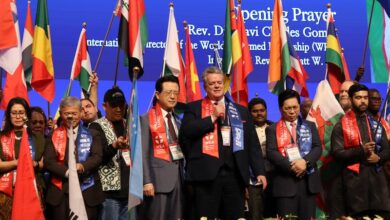Trump, North Korea’s Kim sign historic statement
For 65 years, America’s entrenched old-guard political estate could not deal with North Korea. From President Truman, to Nixon, Reagan, Clinton and Obama, eleven Democrat and Republican presidents have failed at containing North Korean aggression and failed at ending America’s longest war–known as the Korean Conflict.
Now an American president, with no previous political experience, has done what none previously could or would do–meet with the North Korean dictator to find a way forward for peace.
In an agreement signed at their unprecedented summit today in Singapore, U.S. President Donald Trump and North Korean leader Kim Jong Un inked what Trump said was a “comprehensive document” declaring that Kim’s regime would “work towards the complete denuclearization of the Korean Peninsula” while committing to a “lasting and stable peace.”
In exchange, Trump committed to provide “security guarantees” to Kim — including a halt to joint military exercises — as the two nations agreed to establish new relations “in accordance with the desire of the peoples of the two countries for peace and prosperity.”
Japanese Prime Minister Abe lauded Trump for his “leadership” in making the summit happen and hailed it as meaningful in that it resulted in a written confirmation of Kim’s intention to denuclearize.
At a post-summit news conference, Trump touted the agreement as a historic deal, but part of a longer-term process to resolve the nuclear standoff with the North.
“We’re prepared to start a new history and ready to write a new chapter between our two nations,” Trump said.
“The past does not have to define the future,” he added. “Yesterday’s conflict does not have to be tomorrow’s war. Adversaries can become friends.”
The document said follow-up negotiations led by U.S. Secretary of State Mike Pompeo and an undetermined high-level North Korean official would be held “at the earliest possible date.”
At the news conference, Trump also revealed that Kim had told him in their talks that the North was “already destroying a major missile engine testing site” and that inspections to verify the country’s moves by an international contingent were also being discussed.
South Korean President Moon Jae-in and Chinese leader Xi Jinping will also continue strong sanction pressure demanded by Trump. Trump said later that the measures would remain in place until progress on denuclearization was made.
But the agreement, which appeared to echo the April 27 Panmunjom Declaration signed between Kim and Moon, offered few specifics about how the two sides would reach these goals, while also leaving “complete denuclearization” undefined.
The United States and North Korea have been in a technical state of war since the outbreak of the 1950-1953 Korean War, which pitted U.S.-led U.N. troops backing Seoul against Pyongyang’s forces that were aided by China. The conflict ended in an armistice that sealed the division of the peninsula, and the U.S. currently has some 28,500 U.S. service members stationed in South Korea.
Trump announced that the U.S. would be halting its joint war games — which the North views as a rehearsal for invasion.
At a signing ceremony for the document, Trump said the two leaders had developed a “special bond,” while Kim, sitting beside him, called the summit a “historic encounter where we decided to leave the past behind.”
“The world will see a major change,” Kim said through a translator.
Asked by reporters if the agreement was the starting point for a process that would begin the denuclearization of Korean Peninsula, Trump said that such steps would happen “very, very quickly.”
The U.S. president also said that they would meet again and would “absolutely” invite Kim to visit the White House, adding that the two would “meet many times.”
Experts called the document a good first step in keeping diplomacy alive. Other analysts pointed out similarities to a landmark deal between the two sides inked almost 25 years ago to the date. That agreement said each party would abandon the “threat and use of force, including nuclear weapons” and paved the way for the Agreed Framework the following year, bringing the two sides the closest they have ever been to a successful deal.
Stephen Nagy, a senior associate professor at International Christian University in Tokyo, said the main takeaway from the summit was that it represented “a commitment toward more dialogue, toward a process of diplomacy” and called the result a “political win” for both leaders.
“This will be a message that the North can take home to their public that they don’t have to immediately denuclearize, and its a message that Trump can take home to his political base that he understands that denuclearization is complicated and it’s going to be an incremental process.”
Tuesday’s summit was the first-ever between leaders of the North and the U.S. — an improbable meeting that came just months after the two traded personal insults and threats of nuclear war as Trump became the first president to abandon weak diplomatic language in favor of language that the American public, and North Korea, could understand–the U.S. was fed-up with North Korea’s actions and was at a tipping point to end it militarily if needed.
While criticized at the time by American media and democrats as “dangerous”, that language seems to be what ultimately brought North Korea to the bargaining table.
Those barbs, however, seemed a thing of the distant past.
For his part, the North Korean leader said that although there would be challenges ahead, he is willing to closely work with Trump.
“I believe this is a good prelude for peace,” Kim said after a nearly 40-minute one-on-one meeting with the U.S. leader and their translators with Kim reportedly greeting Trump in English, saying “Nice to meet you, Mr. President.”
Moving to a separate room, where they briefly addressed reporters, Kim said his visit had not been an easy journey.
“Well, it was not easy to get here,” Kim said, according to a transcript released by the White House. “The past worked as fetters on our limbs, and the old prejudices and practices worked as obstacles on our way forward. But we overcame all of them, and we are here today.”
Jean Lee, a North Korea expert at the U.S.-based Wilson Center think tank noted that it marked a shift in the two nations’ ties.
“To see President Trump and Kim Jong Un shaking hands warmly and chatting so easily was both stunning and chilling,” she said. “It’s a powerful moment that augers a change in the tense relationship between these two countries.
Tuesday’s summit came after a year of surging tensions between the two nuclear-armed rivals that saw Kim ramp up the development of his weapons programs and in the process bring the peninsula to the brink of conflict.
Last year, the North carried out what was by far its most powerful nuclear test to date and launched a flurry of missiles — including two over Japan — while Trump threatened Pyongyang with “fire and fury” and Kim dubbed him a “mentally deranged U.S. dotard.”
It also made one of the biggest breakthroughs in its missile and nuclear weapons programs — which it has said it needs to defend against the risk of a U.S. invasion — when it announced that it had “completed” its state nuclear program after testing a missile capable of striking most, if not all, of the continental U.S.
But in an unexpected move and after pressure from the Trump administration having been successfully applied, Kim announced in April a shift from a focus on building his nuclear arsenal to one of bolstering his tattered economy. As a part of that process, he also announced a suspension of nuclear and missile tests and the dismantlement of a key atomic testing facility that was carried out last month.
Trump and other top U.S. officials have promised a “bright future” for the North if it quickly relinquishes its nuclear weapons — including economic inducements and a security agreement.
Some political analysts, even those who are not fans of the Trump administration, reluctantly admit that previous presidents have failed miserably.
One democrat political observer commented that, for all the talk of political expertise, degrees from Harvard and experience in American politics, it wasn’t a single one of those eleven previous presidents going back to Truman who got us to the brink of peace after 65 years of a state of war with North Korea. It was a political newcomer who, even with his annoying tweets and often rude and divisive comments, was delivering on making the world a safer place and ending our longest war.
“Who would have thought,” said the observer, “that man would be Donald Trump? Unbelievable!”
–Metro Voice and wire services







